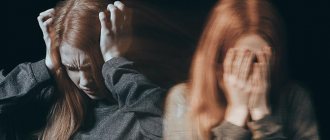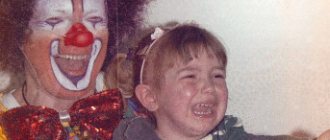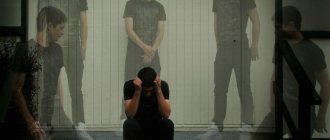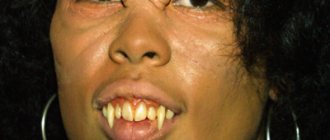April 14, 2021
The fear of losing sanity frightens many people. The great Russian poet A.S. Pushkin wrote in one of his poems:
“God forbid I go crazy.
No, a staff and a scrip are easier.
No, it’s easier work and happiness.”
The second place in frequency of detection after the fear of death is occupied by the fear of madness or lyssophobia (from the Greek lyssa - rabies, madness; phobos - fear). This is an obsessive fear of getting a mental disorder, rabies, “going crazy” (fear of getting mad). This phobia deprives people of the opportunity to lead a normal life. A person is afraid of split personality, hallucinations, losing memory and self-control, etc.
What is phonophobia?
Phonophobia is a (neurotic) anxiety disorder that is part of a group of specific phobias characterized by a fear of loud sounds. In extreme cases, it takes the form of fear of one's own voice. The term phonophobia comes from the Greek words phn, phnma, which mean sound, voice, and phobos, which translates to fear.
It is also called ligyrophobia or acousticophobia. A feeling of anxiety can appear not only as a result of the direct action of the anxiety factor, but also sometimes as a result of its image. For example, the sight of a person inflating a balloon to a size at which it might burst creates an alarming situation, since patients can anticipate the noise that may accompany it.
Reasons for developing a phobia
From a psychological point of view, the reasons for the appearance of any obsessive fears, including lissophobia, are the characteristics of our personality:
- temperament : temperaments such as choleric and melancholic are more susceptible to fear;
- developed imagination;
- high level of anxiety (fear of the future, feeling of uselessness and helplessness);
- the need to “have everything under control”«;
- the pattern of behavior transmitted from parents to children;
- the presence of something threatening or the absence of something that ensures safety. A person does not feel psychological stability, he lacks purpose and meaning in life;
- mental disorders and behavioral disorders (frequent conflicts, difficulty in solving everyday issues, excessive criticism of oneself);
- heredity;
- socio-economic instability of society.
What causes phonophobia?
Various factors may be responsible for the development of this disorder. The researchers emphasize in particular the role of otolaryngological diseases that the patient has had or is experiencing, including, for example, increased hearing sensitivity associated with tinnitus or acoustic trauma due to exposure to loud sounds.
On the other hand, phonophobia can be caused by environmental or genetic factors.
Its determinant, as in the case of other simple phobias, may be a traumatic event accompanied by a loud noise - therefore, the phobia coexists with post-traumatic stress disorder (PTSD). An overly activated limbic system, which is responsible for emotions, predisposes to the disease.
Persons susceptible to lysophobia
About 20% of people are potentially predisposed to developing obsessive fears. Phobias, as a rule, are the lot of people with insufficiently strong, unstable psyches.
Therefore, the “risk group” for developing lissophobia includes:
- suspicious people who are not satisfied with their lives;
- individuals with neuroses, depression and vegetative-vascular dystonia;
- people in whose family there have been recorded cases of mental disorders;
- individuals with other phobias and disorders that are accompanied by panic attacks.
- Elderly people are at particular risk. They are afraid of dementia, afraid of dementia (senile dementia, senile insanity).
- Personal psychological trauma is another cause of fear. If a person witnesses someone's madness, then there is a high probability that he will be afraid that the same thing will happen to him. In addition, fear may arise after personal experience of treatment for any mental disorder.
Symptoms
Phonophobia manifests itself in a variety of psychosomatic diseases. In response to an active anxiety stimulus, the patient reacts with extremely strong, irrational, involuntary fear. He loses control over his behavior. He becomes aggressive, distracted, irritable, agitated and panicky. May be accompanied by physical symptoms - headache and dizziness, shortness of breath, increased blood pressure, muscle tension, abdominal pain, nausea. Phonophobics avoid places and situations in which there is a risk of a phobic factor.
Symptoms of a phobic disorder
The peculiarity of a phobia is that it is impossible to name the exact object of fear.
Signs of lissophobia worsen in moments of stress or emotional upsurge. In other words, thoughts of madness appear only when the psyche is under stress. Conflict in the family or at work, a quarrel with a friend, new responsibilities from the boss, jostling on the subway and much more can make the patient angry. At such moments, anxiety and irritation increase, and the reaction to light, sound, and voices intensifies. The patient wants to quickly run away and hide in a dark corner, or he has a desire to destroy everything.
In addition, it may be characterized by:
- adrenaline surges in the blood;
- panic attacks;
- difficulty breathing;
- dizziness;
- feeling of tightness in the chest;
- disorientation in space;
- anxiety states.
What could be the consequences?
In extreme cases, phonophobia can lead to misophonia, a hypersensitivity to sound. The term comes from the Greek words misos - “to hate” and phone - “sound”. The phobia is characterized by a sharply negative emotional reaction in response to certain sounds, for example, creaking doors, ticking clocks, footsteps, typing, loud breathing, slapping, squelching, sniffling, children crying, etc.
Disgust usually concerns sounds made by those closest to you. This condition was first described in 2000. An inadequate way to cope with this condition is the avoidance technique - using earplugs, listening to music through headphones to cut yourself off from unpleasant sounds.
This method can weaken social bonds and isolate and even increase the number of sounds that the patient cannot tolerate. Techniques used in tinnitus treatment and psychotherapy can improve quality of life in misophonia. Habituation therapy, also known as TRT training (Tinnitus Retraining Therapy), has shown good results. It consists in suppressing conditioned reflexes. It seeks to evoke pleasant associations with sounds that the patient finds unpleasant.
Causes and treatment
The prerequisites for the occurrence of nosophobia are the same as for other anxiety disorders - suspiciousness, emotional lability, genetic predisposition, chronic stress. In this case, the provoking factor is usually the illness or death of someone close, or an episode of illness in the patient himself.
It is important to note that if a patient has nosophobia, he can describe the symptoms of the “causal” disease very plausibly, since he actually experiences them. True, the cause of these sensations is not organic (organ damage), but psychogenic.
Nosophobia should not be considered a harmless whim that only spoils your mood. On the one hand, nosophobia as an anxiety-phobic disorder exhausts the body with constant anxiety and panic attacks, and the vegetative manifestations of the disease (tachycardia, rapid breathing, dizziness, fainting, sweating and trembling) unbalance the nervous and cardiovascular systems, causing their real diseases. On the other hand, constantly looking for symptoms of illness and excessive attention to sensations from the internal organs disrupts their automatic regulation, which can also cause an organic disease.
Nosophobia requires treatment. This condition should be treated by a psychotherapist. The specialist will find the cause of the disease and help the patient change negative attitudes, restore calm and joy of life. There is no need to endure or try to cope with the disease on your own - treatment from a professional will be effective, and the disease will no longer bother you.
The specialists of the Alliance Center for Medical Treatment have extensive experience working with nosophobia. It is not enough to influence the symptoms - it is important to find the cause of the disease, otherwise it will return again and again. Our approach to treatment provides optimal and lasting results.
How is phonophobia treated?
Phonophobia, like other simple phobias, requires the help of a specialist - a psychologist, psychiatrist or therapist. In treatment, in addition to psychoanalysis, which examines the source of the disorder, cognitive behavioral therapy is used, which serves to change negative, incorrect emotions and thoughts associated with sounds into constructive and favorable ones.
Most often, gradual desensitization of phonophobes occurs. The first step of so-called desensitization is the development of a hierarchy of phobic situations. Then an alarming situation is artificially caused - initially of low intensity. Through concomitant desensitization, relaxation techniques reduce the intensity of anxiety to a phobic level. Relaxation techniques include breathing exercises, muscle relaxation, music therapy, yoga, meditation, etc. In more severe cases, drug therapy with anxiolytics may be required.
Causes of fear of ticks
Reasons for developing fear of ticks:
- Past illness. Most people who have had scabies are afraid of reinfection. This is also due to the fact that many former patients still have mild periodic itching and dermatitis.
- Monitoring the patient. Perhaps the person did not suffer from scabies himself, but observed someone who had it. And it became a psychological trauma. The likelihood of such a development is especially high if the child has seen someone suffering from scabies.
- Disgust. Some people experience not so much fear as disgust. This may be due to personality traits, for example, excessive cleanliness, or to trauma. Perhaps the person had a difficult childhood in unsanitary conditions.
- Fear of getting infected. Most often you hear that ticks carry encephalitis, but this is not the only disease that these insects carry. This is what scares some acarophobes. But this reason does not apply to the fear of subcutaneous (scabies) mites.
- Allergies, skin irritation. Some people mistake this for scabies.
- Other mental disorders. Depression, OCD, anxiety disorder, schizophrenia, paranoid disorder - acarophobia often develops against the background of these diseases. Fear of ticks can also develop against the background of head injuries, intoxication, and somatic diseases.
Interesting! Acarophobia is a rare phobia.
How to get rid of the fear of ticks
The main method of treating fear of ticks and small insects is psychotherapy. In particular, the technique of gradual rapprochement, hypnosis, and EMDR is used. As an aid, the psychotherapist prescribes medications: antidepressants, tranquilizers, sedatives. Art therapy and autogenic training can be used as self-help.
Diagnosis of fear of ticks
The main diagnostic method is a conversation with a psychologist and observation of the client during the conversation. It is important to determine all the features of the course of a phobia, to distinguish normal fear from irrational fear, and to differentiate acarophobia from other disorders. To do this, the psychologist studies the client’s complaints and life history. The specialist looks for the classic triad of phobic symptoms: anxiety that increases upon contact with the object of fear, somatic manifestations, and an avoidance reaction.
Signs and Symptoms of Fear of Ticks
The main psychological symptom is the avoidance reaction. Acarophobe tries his best to avoid encounters with ticks. A person constantly sprays himself and his home with chemicals and refuses to go for walks. He uses only personal items in everything and avoids traveling on public transport. At the same time, he regularly conducts self-examination of his skin and belongings and visits doctors. Almost all acarophobes read medical literature, many are fond of self-medication (destroying false ticks).
If an acarophobe nevertheless encounters a tick or small insect, then he has a panic attack. At the same time, it seems to him that beetles are crawling on him. Uncontrollable itching begins, due to which the acarophobe injures his skin.
Other somatic manifestations of fear of ticks:
- nausea,
- vomit,
- headache,
- dizziness,
- sweating,
- tachycardia,
- arrhythmia,
- chills,
- tremor,
- feeling of suffocation.
In a moment of panic, acarophobe becomes dangerous to himself and others. Some people fall into a stupor, others try to destroy the insect. In trying to kill the “enemy,” a person is capable of harming himself. By negligence, he can poison himself and others, or burn down a house.
Note! The intensity of the phobia depends on the severity of the condition. For some acarophobes, symptoms are noticeable only when encountering insects; other people are constantly haunted by fear and anxiety; some feel ill at the mere mention of ticks.










